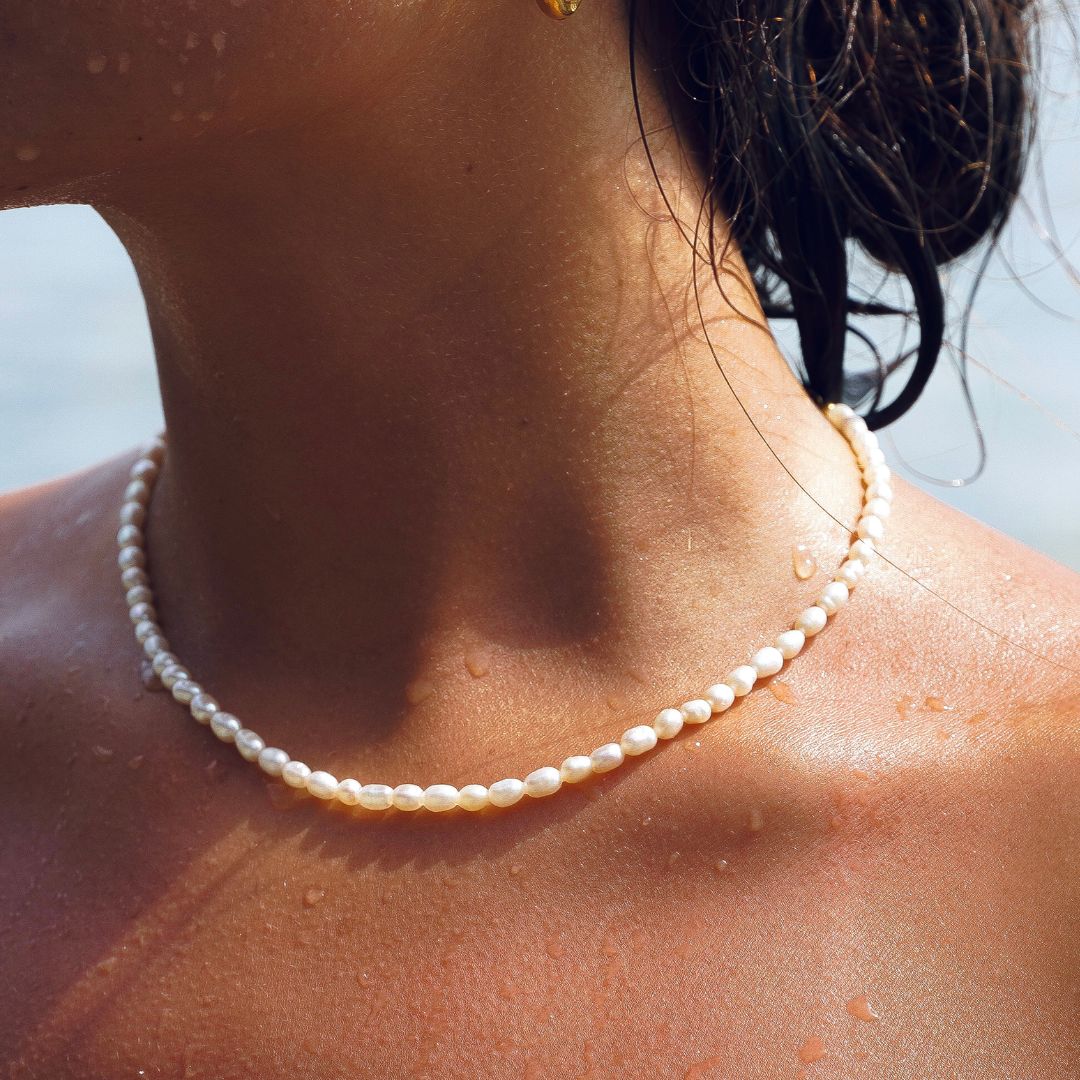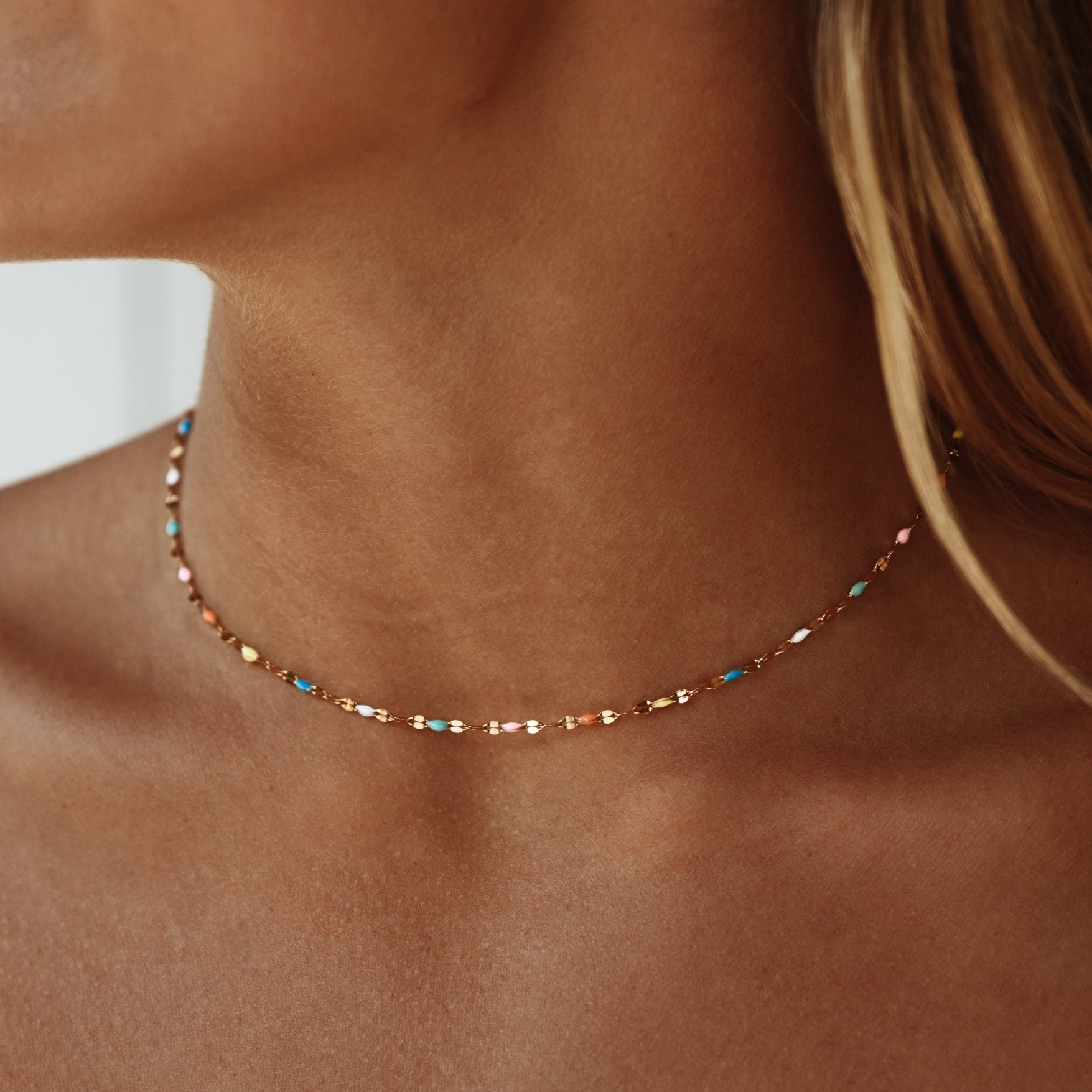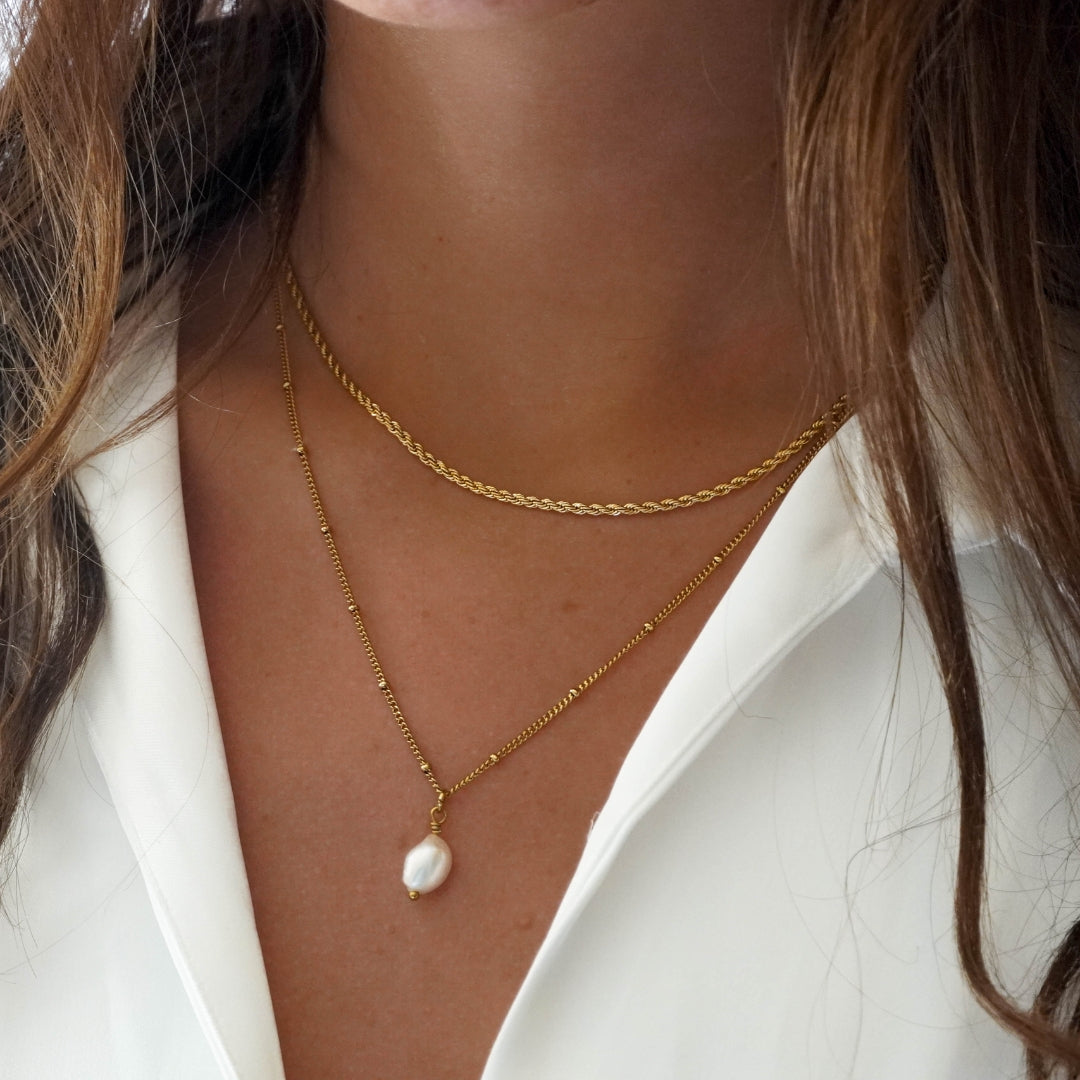
Does Waterproof Jewelry Tarnish?
Waterproof Jewelry, intended to resist water, can still tarnish if consistently exposed to moisture. This tarnishing occurs due to chemical reactions between metals and the surrounding environment. Understanding the factors influencing tarnish, like metal composition and protective coatings, is important. While waterproof pieces offer some protection, prolonged moisture contact can lead to tarnishing. It's important to be aware of proper care methods to maintain your jewelry's luster. To explore further into the science behind tarnishing, types of waterproof jewelry, and effective maintenance tips, check out more details on how to keep your jewelry in pristine condition.
The Science Behind Tarnishing
Understanding how metals react with moisture and oxygen is vital in comprehending the science behind tarnishing jewelry. When moisture and oxygen come into contact with metals, chemical reactions occur that lead to tarnishing. The metal composition plays a significant role in how quickly tarnishing happens. For example, metals like silver and copper are more prone to tarnish compared to metals like gold and platinum.
The chemical reactions that take place on the surface of the metal involve the formation of metal oxides or sulfides. These compounds result from the interaction between the metal, moisture, and oxygen, leading to the discoloration and dullness commonly seen in tarnished jewelry. Additionally, impurities in the metal can accelerate the tarnishing process by providing more sites for the chemical reactions to occur.
Types of Waterproof Jewelry
Various types of waterproof jewelry are designed to guarantee exposure to moisture and prevent tarnishing. When it comes to fashion trends, waterproof jewelry has become increasingly popular due to its durability and versatility. From waterproof bracelets and necklaces to earrings and watches, there's a wide range of options to choose from that cater to different styles and preferences.
To guarantee the longevity of your waterproof jewelry, proper care is essential. Regular cleaning with a soft cloth and mild soap can help maintain its shine and prevent buildup of dirt and grime. Additionally, storing your waterproof pieces in a dry place away from direct sunlight can further prevent tarnishing.
When selecting waterproof jewelry, consider the materials used. Stainless steel, titanium, and silicone are popular choices known for their resistance to moisture and corrosion. These materials not only offer durability but also provide a stylish look that complements various outfits. By staying informed about the latest fashion trends and practicing good jewelry care, you can enjoy your waterproof pieces for years to come.
Factors Affecting Tarnish Resistance
When considering the resistance to tarnish in waterproof jewelry, factors such as the material's corrosion resistance, exposure to moisture, and the presence of protective coatings and finishes play vital roles.
These elements directly impact the longevity and durability of your jewelry by protecting it from tarnishing and maintaining its aesthetic appeal over time.
Understanding how these factors interact can help you choose jewelry that will remain tarnish-free and beautiful for years to come.
Material's Corrosion Resistance
For jewelry to possess high tarnish resistance, the material's corrosion resistance is a critical factor that must be considered. Rust prevention and corrosion control play significant roles in determining how well a piece of jewelry withstands tarnishing.
Materials like stainless steel, titanium, and certain alloys exhibit excellent corrosion resistance properties, making them less prone to tarnish compared to metals like silver or copper. Stainless steel, for example, contains chromium, which forms a protective layer on the surface when exposed to oxygen, preventing rust and corrosion.
Understanding the corrosion resistance of different materials is essential in selecting jewelry that will maintain its aesthetic appeal over time, especially when exposed to various environmental factors.
Exposure to Moisture
To enhance the tarnish resistance of jewelry, understanding how exposure to moisture impacts different materials is essential.
Moisture exposure plays a significant role in the tarnishing process of jewelry. When waterproof jewelry comes into contact with moisture, especially in the form of water or humidity, it can accelerate tarnish formation. This is because moisture often contains chemicals and salts that react with the metals in jewelry, leading to corrosion and tarnish.
Waterproof jewelry, although designed to resist water, isn't entirely immune to the effects of prolonged moisture exposure. Hence, it's important to limit the contact of waterproof jewelry with moisture to maintain its tarnish resistance and keep it looking pristine for longer periods.
Protective Coatings and Finishes
Protective coatings and finishes play an essential role in enhancing the tarnish resistance of jewelry by creating a barrier against environmental factors.
Protective coatings, such as rhodium plating or lacquer, provide a durable layer that shields the metal underneath from tarnishing agents like moisture and chemicals. These coatings not only offer protection but also contribute to the overall durability of the jewelry piece.
Finishes, like polishing or anti-tarnish treatments, can further improve the maintenance of jewelry by reducing the impact of tarnish over time.
Proper care and regular inspection of these protective layers can help extend the lifespan of your jewelry and preserve its aesthetic appeal. Remember, investing in high-quality protective coatings and finishes is key to keeping your jewelry looking its best.
Tips for Maintaining Jewelry Shine
To maintain the shine of your jewelry, it's important to take into account its waterproof durability and implement measures to prevent tarnishing. By understanding how to safeguard your jewelry from moisture and pollutants, you can guarantee its longevity and brilliance.
Regular cleaning and proper storage are key steps in preserving the luster of your precious pieces.
Waterproof Jewelry Durability
Maintaining the shine of your waterproof jewelry requires consistent care and attention to detail. To guarantee waterproof jewelry longevity, it's essential to follow tarnish prevention strategies diligently.
Regularly cleaning your jewelry with a mild soap and soft brush can help remove dirt and oils that can cause tarnishing. Additionally, storing your jewelry in airtight containers or anti-tarnish pouches can protect it from exposure to moisture and air, which are common causes of tarnish.
Avoid exposing your waterproof jewelry to harsh chemicals, perfumes, or lotions, as these can also accelerate tarnishing. By implementing these simple maintenance practices, you can help preserve the durability and shine of your waterproof jewelry for years to come.
Preventing Jewelry Tarnish
Proper care and storage are key to preventing tarnish and maintaining the shine of your jewelry.
To prevent tarnish, avoid exposing your jewelry to chemicals like perfumes, lotions, and hairsprays, which can accelerate the tarnishing process.
When storing your jewelry, opt for airtight containers or anti-tarnish pouches to minimize exposure to air and moisture, which are common causes of tarnish. Additionally, consider using tarnish-resistant materials like tarnish strips or anti-tarnish cloths to protect your jewelry.
Regularly clean your jewelry with a soft cloth to remove any dirt or oils that could lead to tarnishing. By following these simple steps, you can effectively prevent tarnish, ensuring your jewelry stays bright and lustrous for longer.
Cleaning Methods for Tarnished Jewelry
For cleaning tarnished jewelry, consider utilizing a gentle polishing cloth or a non-abrasive jewelry cleaner. When dealing with tarnished pieces, it's important to opt for chemical-free cleaning methods to prevent further damage. A soft polishing cloth is a safe and effective way to remove light tarnish by gently rubbing the surface of the jewelry. For more stubborn tarnish, a non-abrasive jewelry cleaner specifically formulated for the type of metal used in the piece can be a good solution.
Ultrasonic and steam cleaning are advanced methods best left to professionals. Ultrasonic cleaners use sound waves to create bubbles that implode, effectively cleaning intricate parts of the jewelry that are hard to reach with a cloth. Steam cleaning, on the other hand, uses high-pressure steam to dislodge dirt and grime. Both methods can be highly effective but may not be suitable for all types of jewelry, so it's important to consult a professional before using them.
Myth Busting: Waterproof Vs. Tarnish-Proof
When it comes to jewelry care, understanding the difference between waterproof and tarnish-proof is vital for preserving your precious pieces. There are common waterproof misconceptions that lead people to believe that waterproof jewelry is also tarnish-proof. It's important to clarify that while waterproof jewelry can withstand exposure to water, it doesn't guarantee protection against tarnishing. Tarnish prevention techniques are essential for maintaining the luster of your jewelry over time.
Waterproof jewelry may resist water damage, but it isn't immune to tarnishing, which is a result of chemical reactions with the metal and the environment. Tarnish-proof jewelry, on the other hand, is specifically treated or made with materials that inhibit tarnishing, providing an added layer of protection.
To keep your jewelry looking its best, consider storing it in anti-tarnish pouches or using tarnish-resistant coatings. Regular cleaning and proper maintenance are also key in preventing tarnish build-up. By understanding the distinctions between waterproof and tarnish-proof, you can implement effective tarnish prevention techniques to ensure the longevity of your jewelry.
Exploring the Durability of Atolea's Waterproof Jewelry
Can I Wear Waterproof Jewelry in the Shower or While Swimming?
You can wear waterproof jewelry in the shower or while swimming. To safeguard your pieces, make sure they are made of materials like stainless steel, titanium, or silicone. Regularly clean and dry them to prevent tarnishing and damage.
What Should I Do if My Waterproof Jewelry Starts Tarnishing?
If your waterproof jewelry starts tarnishing, make sure proper metal maintenance. Use rust prevention methods like storing in a dry place, avoiding harsh chemicals, and periodic cleaning. Consider professional cleaning for severe tarnishing to restore its shine.
Are There Specific Cleaning Products Recommended for Waterproof Jewelry?
To clean waterproof jewelry effectively, use mild soap and warm water. Avoid harsh chemicals to prevent damage. Regularly polish with a soft cloth. Store in a dry place when not worn to maintain its shine and prevent tarnishing.
Will Waterproof Jewelry Tarnish Over Time With Regular Wear?
To maintain waterproof jewelry's longevity and prevent tarnishing, clean it regularly with mild soap and water. Avoid harsh chemicals and store it properly when not in use. Regular care guarantees your waterproof jewelry stays looking great.
How Can I Tell if My Jewelry Is Tarnished or Just Dirty?
To determine if your jewelry is tarnished or dirty, inspect for discoloration or dark spots. Use a jewelry cleaning cloth or solution to gently polish. Prevent tarnish by storing pieces in anti-tarnish pouches or airtight containers.
Conclusion
To summarize, while waterproof jewelry may offer some resistance to tarnishing, it isn't completely tarnish-proof. Factors such as metal composition, exposure to chemicals, and proper maintenance play significant roles in preserving the shine of your jewelry.
By following the tips and cleaning methods outlined in this article, you can guarantee that your waterproof jewelry remains pristine and beautiful for years to come.






















Leave a comment
This site is protected by reCAPTCHA and the Google Privacy Policy and Terms of Service apply.